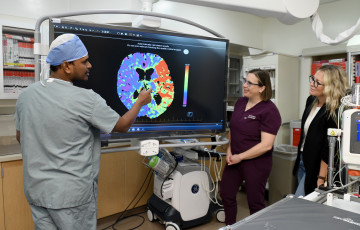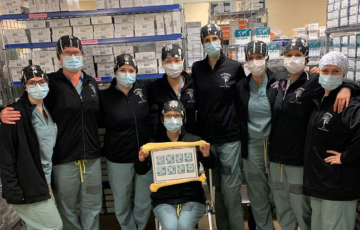Electroencephalography
Electroencephalography (EEG) is a well established electrodiagnostic test that involves placing multiple electrodes over the scalp and recording brain activity. The common diagnostic use of the EEG is in establishing diagnoses of seizure or seizure types or spells (paroxysmal disorders) where the cause is unknown. EEG's may also be used to evaluate encephalitis, encephalopathy and degenerative diseases of the brain.
An EEG technologist performs the testing. The test takes anywhere from 60 to 90 minutes. At times, recording may be done when the patient is asleep. This may require a patient taking a mild sedative and/or being sleep deprived for the test.
Evoked potentials
Evoked potentials are electrical responses recorded from the brain, spinal cord or peripheral nerve that are evoked by external stimuli to the visual system, the auditory system or the somatosensory system. Surface recording electrodes are placed over the scalp, neck or spine, depending on the specific type of stimulus and response to be recorded.
Visual Evoked Responses (VEP)
This visual evoked responses test examines the integrity of the visual pathway from the retina to the occipital cortex of the brain. The patient is asked to fixate on a video screen and watch an alternating checkerboard pattern. The testing should be done with eyeglasses if required by the patient. Each eye is tested separately. The test takes about 45 minutes to 1 hour. It is used commonly for the potential diagnosis of Multiple Sclerosis but also to assess complaints of visual disturbances or suspected abnormalities in visual pathway function.
Brain Stem Auditory Evoked Responses (BAER)
The brain stem auditory evoked responses test checks the integrity of the auditory pathway in the brain stem. Electrical responses generated by a series of clicking sounds are recorded as they travel through the auditory nerve, the brain stem and into the auditory cortex. The ears are tested separately. The test takes about 45 minutes to 1 hour. he testing is commonly done for evaluation of hearing problems, dizziness, suspected brain stem lesions and suspected Multiple Sclerosis.
Somatosensory Evoked Responses (SEP)
The somatosensory evoked responses test assesses the sensory system from peripheral nerves in the extremities, through the spinal cord and to the sensory cortex of the brain. Recordings can be from the arms, legs or both. A stimulus is applied to the wrist or ankle, causing a muscle twitch. Then the impulse transmitted to the brain is recorded. SEP's are commonly performed for evaluation of suspected abnormalities in the spinal cord, peripheral nerve or for evaluation of possible Multiple Sclerosis.
24-hr Ambulatory EEG
For this test, electrodes are placed on the scalp and the patient carries a small recorder that is wired to the scalp electrodes. Brain activity is then recorded for a 24 hour period. Patients are required to keep a diary to try and determine if any of their symptoms are related to any abnormal brain activity. This test is useful for a diagnosis of unexplained spells and to determine if patients are having frequent seizures that they are not aware of.
Nerve conduction studies (NCS)
Nerve conduction studies (NCS) are tests used to evaluate the function of the peripheral nerves. A brief low intensity electric current is applied to individual nerves, with recording electrodes placed on the surface of the skin. The test is performed by a technician or a physician. The physician provides interpretation of the test.
Electromyography (EMG)
Electromyography (EMG) is a test used to assess disorders of muscles or nerves. A thin electrode is inserted into the muscle. It records responses both at rest and during contraction of the muscle. Disposable (non-reusable) sterile needles are used and there is no risk of transmission of infectious diseases. The test is performed and interpreted by a physician.
NCS and needle EMG are commonly used for evaluation of:
- carpal tunnel syndrome
- compressive or traumatic peripheral nerve injuries
- neuropathy
- muscle diseases (myopathy)
- myasthenia gravis and amyotrophic lateral sclerosis (Lou Gehrig's Disease)
EMG and NCS are performed at the Royal Jubilee Hospital, Victoria General Hospital and at the Nanaimo Regional General Hospital.
Electronystagmogram (ENG)
The purpose of the ENG is to determine whether or not dizziness may be due to a problem within the vestibular/balance system.
What does the ENG test entail?
A technologist will take a short medical history. There are three main parts to the ENG. The tracking test evaluates movement of the eyes as they follow a visual target. The positional test looks at eye movement associated with position change. The caloric test* measures responses to warm and cool water or air in the ear.
*If the temperature of the ear canal is warmed or cooled, we should see a reflex movement of the eyes. The reflex is a side-to-side eye movement which is called a nystagmus. When the reflex occurs, your eyes are moving involuntarily and you may perceive this as dizziness. The dizzy feeling typically stops well before you are sent home.
Does the ENG test hurt?
No.
Are there any after effects from an ENG test?
Some people may still be a little dizzy when the test is completed. It is advisable to have someone available to drive you home in case this happens to you.
Is there any preparation for the ENG test?
Yes.
Certain medications affect this test and need to be stopped 48 hours prior to the procedure. Check with the specialist who ordered the test whether you need to discontinue any of your medications.
Do not stop any medications until you have checked with your physician that is is safe to do so. Alcohol and caffeine should also be discontinued for 48 hours prior to the test. Please remember not wear mascara or eyeliner on the day of the test.




